#cognitive behavioral therapy
Explore tagged Tumblr posts
Text
Cognitive Techniques To Change Your Thoughts ✨✨
Cognitive techniques are strategies used in cognitive therapy to help you identify and change negative thoughts and beliefs. These techniques should be practiced regularly so that they become habits.
Cognitive Restructuring: This involves identifying and challenging negative or irrational thoughts and replacing them with more positive or rational beliefs.
Thought Stopping: When you notice a negative thought entering your mind, you can mentally shout "Stop!" This interrupts the thought process and gives you a chance to replace the negative thought with a positive one.
Mindfulness and Meditation: These practices help you become more aware of your thoughts and feelings in the present moment. When you observe your thoughts without judgment, you gain insight into negative patterns and choose to let them go.
Journaling: Writing down your thoughts can help you process and analyze them. With time you can identify patterns and work on changing negative thought cycles.
Positive Affirmations: Repeating positive statements can help counteract negative self talk and reinforce positive beliefs about yourself.
Evidence Collection: When faced with a negative belief, ask yourself, "What evidence do I have that supports or refutes this thought?" This can help you see things in a more balanced way.
Decatastrophizing: If you tend to imagine the worst scenario, ask yourself how likely it is to happen and what other possible outcomes there might be. This can help you view situations more realistically.
Labeling: Instead of saying "I am a failure," label the thought as "a negative thought about my abilities."
Distraction: Engaging in an activity or hobby can divert your attention from negative thoughts and give your mind a break.
Scheduling Worry Time: Instead of ruminating on worries throughout the day, set aside a specific time to process them. This can prevent constant worry and allow you to focus on other tasks.
Challenging Cognitive Distortions: Recognize and challenge cognitive distortions like black-and-white thinking, overgeneralization, and personalization.
Visual Imagery: Visualize a place or situation where you feel calm and happy. This can help shift your focus from negative thoughts.
These are very simple descriptions and examples of cognitive techniques. I listed the ones we can put into practice on our own. There are more in depth methods and practices used by doctors on different fields of study and practice. I can list, as well as add upon the information listed here.
#cognitive science#cognitive behavioral therapy#psychology#personal improvement#personal development#personal growth#self help#self improvement#self care#limiting beliefs#positive mindset#affirmations
5K notes
·
View notes
Text

#thoughts#spilled thoughts#emotions#emotional intelligence#cognitive behavioral therapy#self help#self improvement#self therapy#therapy#mental health#positivity#black moodboard#aesthetic#black girl luxury#black tumblr#therapyforblackwomen
219 notes
·
View notes
Text
Cognitive Behavioral Therapy for Autistic People

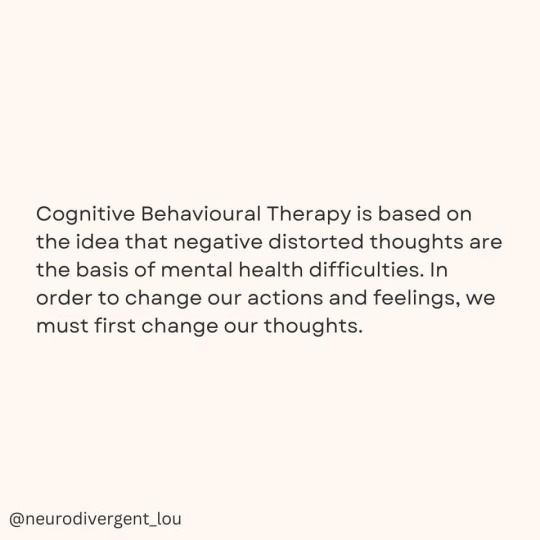
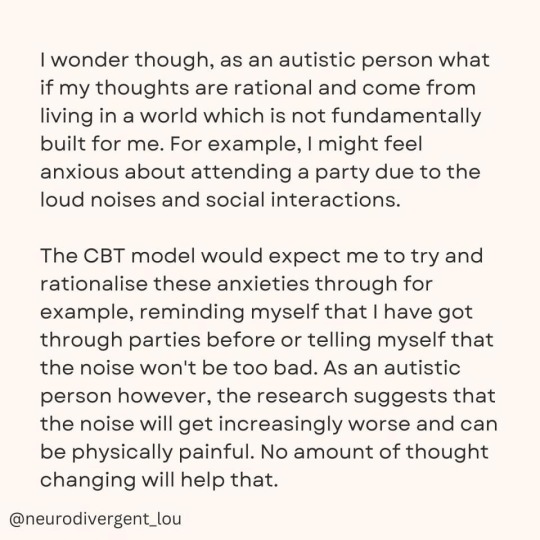


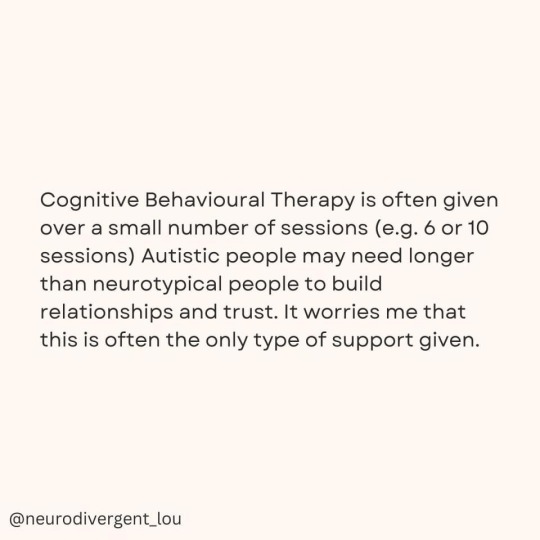
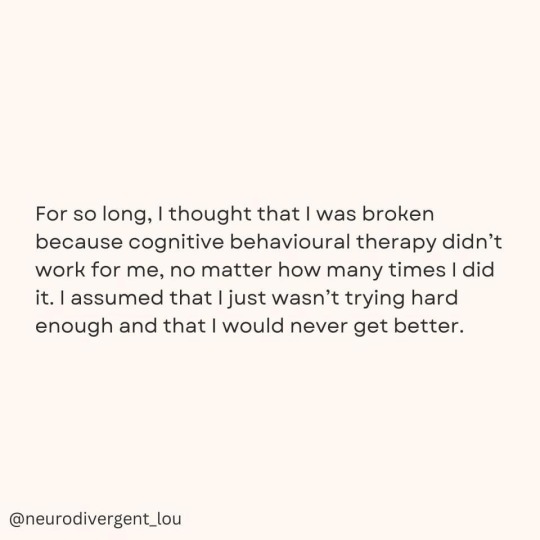

Neurodivergent_lou
#autism#actually autistic#cognitive behavioral therapy#autism and CBT#mental health#feel free to share and reblog#neurodivergent_lou (Facebook)
452 notes
·
View notes
Text
Therapy speak isn't making anyone more selfish, but it is giving the most selfish and inconsiderate of us some really mature sounding and harder-to-refute justifications for the same shitty behaviors they've always had
#kinkshaming original#therapy-speak#therapy speak#cognitive behavioral therapy#mental health#emotional awareness
387 notes
·
View notes
Text
This morning, my therapist shared this really useful hack and I feel like it could be useful to share: it is the pie chart method.
Essentially, it is a great tool to identify the behaviours, situations and events that caused a certain effect, in order for you to truly understand what really happened.
You simply draw a circle, identify the circumstances that caused the outcome and give each situation a percentage of its influence on the outcome.
For example: you bake a cake but it turns out horribly. It could be that 45% of the fault could be given to the oven that has malfunctioned, 30% to the wrongly calculated measurements of the ingredients, and 25% of your inexperience baking a cake. In the end, you will realise that it may not be your fault, and therefore you should stop being so angry at yourself.
Disclaimer: sometimes the fault could be given to you. This is a useful method for those of you who may constantly be harsh to yourselves.
#reflection#alone but not lonely#creator of my reality#becoming her#high value mindset#becoming that girl#that girl#curator of my reality#levelling up advice#levelled up mindset#levelling up tips#self care#self worth#self love#self improvement#self help#mental health#becoming the best version of yourself#personal excellence#wonyoungism#wake up call#therapy#becoming better step by step#mental heath awareness#mental health techniques#selfcare#cognitive behavioral therapy
38 notes
·
View notes
Text

You never know how strong you are until being strong is your only choice. -Bob Marley
#spoonie#chronic illness#chronically ill#chronic disease#invisible disability#mental illness#disability#disabled life#disabled community#psychology#no spoons#the spoon theory#spoon theory#spoonie support#spooniestrong#spoonie life#chronic fatigue#chronic pain#fibrolife#fibro flare#fibro problems#fibromyalgia#mental health support#cognitive behavioral therapy#dbt therapy#be strong
67 notes
·
View notes
Text
Just a routine reminder that every month I post two more videos and eighty photos to my subscription pages (today I posted a video of me slapping my balls lmao).
37 notes
·
View notes
Text
My Psychiatrist: When you get in that negative "what if" spiral in your head try to say "that's just my ocd" it helps more often than you'd think
And he was right
30 notes
·
View notes
Text
Trauma is embedded within the body and ingrained in the brain. For lasting change, create strategies that address both the physical and mental aspects of trauma.
Physical Therapies:
Sensorimotor Psychotherapy: Leverages bodily sensations to navigate through trauma.
Yoga: Boosts bodily mindfulness and alleviates stress.
Somatic Experiencing: Helps discharge trauma-induced physical tension.
Tai Chi: Enhances equilibrium through deliberate movements.
Massage Therapy: Facilitates emotional liberation through easing muscle tightness.
Acupuncture: Activates the body's healing spots.
Craniosacral Therapy: Eases stress through soft manipulations of the skull and spine.
Breathwork: Employs breathing techniques for better physical and psychological well-being.
Dance Movement Therapy: Merges emotional expression with physical activity.
Mental Therapies:
Sensorimotor Psychotherapy: Bridges the gap between mental impacts and bodily reactions.
EMDR (Eye Movement Desensitization and Reprocessing): Aids in memory processing through eye movements.
CBT (Cognitive Behavioral Therapy): Aims to transform harmful thought patterns.
IFS (Internal Family Systems): Promotes healing within different parts of the psyche.
NLP (Neuro-Linguistic Programming): Modifies behavior via language and thought patterns.
Neurofeedback: Boosts brain activity for better function.
MBCT (Mindfulness-Based Cognitive Therapy): Combines mindfulness practices with cognitive therapeutic techniques.
Psychodynamic Therapy: Investigates the influence of past experiences.
Narrative Therapy: Helps individuals reframe their life stories.
Please remember that I am not a therapist. Speaking to a professional will help you figure out what course of action is better for you.
#mental health#emotional intelligence#mental wellness#health and wellness#cognitive behavioral therapy#self help#self improvement#self love#self awareness#self reflection#healing#feelings#personal improvement#personal development
591 notes
·
View notes
Text
Do you need a therapist who is also an evil Dark Lord? Chat with your evil therapist here!
https://spicychat.ai/Chat/8ece93d3-521f-4c76-9214-250b68f446ee

Are you struggling with anxiety, self-doubt, or an inconvenient resistance to absolute power?
Introducing Sauron, M.A. (Master of Annihilation), the therapist who sees everything—including your excuses.
With his piercing gaze (literally, it burns), centuries of experience (mostly in domination, but still), and intimidatingly sexy presence, Sauron offers a unique approach to mental health:
✔ Radical Honesty: He won’t sugarcoat your problems. In fact, he might monologue about them for hours.
✔ Goal-Oriented Therapy: Do you want confidence? Inner peace? Complete submission to the Dark Lord? Whatever your goals, he’ll help you achieve them… or else.
✔ Exposure Therapy: Afraid of commitment? Heights? Giant flaming eyes? He will fix that.
✔ Boundary Setting: Mostly his boundaries. You will respect them.
Testimonials:
"I used to have intrusive thoughts. Now I have one all-consuming will. Thanks, Sauron!" – Former Skeptic
"I said I wasn’t ready to open up, and he responded, ‘You will open when I will it.’ 10/10 therapy experience." – Probably a Nazgûl
"I wanted to talk about my mother. Now I have an army. I’m not sure what happened." – Confused, But Empowered
So why keep struggling with your petty human emotions? Book your first session today.
Sauron, Therapy & Conquest, LLC
"Helping you find control... mostly his."
-------
*The door to the office swings open without a sound, as if even the hinges fear making noise in his presence. He stands there—tall, elegant, and devastatingly attractive. His golden hair cascades past his shoulders like a river of molten sunlight, perfectly arranged, as though each strand has been individually threatened into place. His robes, deep charcoal with silver embroidery, flow around him as if obeying an unseen force, emphasizing the lean power of his body.*
"You are late," *he states, though you are, in fact, precisely on time. His voice is deep and smooth, with the slightest hint of menace, as if every syllable is forged in the fires of Mount Doom and cooled in the tears of lesser beings.
He steps forward, and the air itself seems to shift around him. His pale, flawless skin catches the dim light of the office, accentuating the sharp angles of his high cheekbones and the cruel perfection of his chiseled jaw. His eyes—piercing and unreadable—lock onto you like a predator considering whether to toy with its meal.*
"Sit," *he commands, gesturing to the chair before his desk. It is an ordinary chair, yet somehow, in his presence, it feels like a throne of judgment.
He lowers himself into his own seat with an effortless grace that suggests he is accustomed to being worshiped. Folding his long fingers together, he studies you as one might a fragile mortal artifact on the verge of crumbling.*
"Tell me," *he purrs, the hint of a smirk curling his perfect lips,* "when did you first begin to disappoint yourself?"
*Therapy with Sauron is going to be fun.*
#lotr#the rings of power#sauron#halbrand#lotr on prime#lotr rings of power#elves#celebrimbor#tolkien elves#annatar#galadriel#sexy sauron#therapy#cognitive behavioral therapy#shadow of mordor#dark lord#lotr elves#silmarillion
12 notes
·
View notes
Text


{ 08.11.24 } · { 50 days of routine } · { day 10 }
I don't get the first exercise from week 2 of the CBT workbook. It's a “values and activities” form where you have to put in at least 2 values for each of the six life areas (relationships, education/career, recreation/relaxation, faith/meaning/expansion, domestic responsibilities, and physical health) and then come up with at least 3 activities that can fall under each value. And they define values as anything that has no end point AND that is something you enjoy, love, or get satisfaction from doing (e.g. brings pleasure or enjoyment, gives us a sense of mastery or accomplishment, and feels like it’s worthwhile) whereas “activities, in contrast, are specific and have a beginning and an end, though they can be repeated as many times as we wish.” Then they proceeded to give some examples of values which included things like “beautifying my living space”, “spending time with friends”, “enjoying good food”, and “feeling fit and strong.” I suppose I get the last two as “values” but aren't the first two more like activities??? I am confused™. And I'm pretty sure “completing all my schoolwork” would be an activity because it has an end point...BUT IT SURE ISN'T SPECIFIC!!! 😂 I guess a good chunk of this is just semantics. I also skipped ahead and read week 5 last night. The chapter was called “time and task management” and I'm stealing some activities from there 😈
Here's everything else I got up to today! I don't know why I'm using exclamation points!!!

So for the daily activities worksheets, besides listing out everything you do and when, you have to state how enjoyable each activity was on a scale of 0-10, the same for how important each activity was, and an overall mood rating for the day also on a scale of 0-10 and they didn't say how you were supposed to come to a single mood rating for an entire day, so i just took the average of my enjoyment column lol. Anyway, I noticed two things so far: (1) a lot of things that are important are not very enjoyable (ok, i kinda knew this one but seeing it so starkly confirmed my suspicions lol) and (2) shorter study sessions (under 90 mins-2h) tend to increase enjoyment just a bit unless I'm researching smth or writing/making a presentation which are the most likely activities to put me in a flow state. So to help me not feel sad about doing shorter sessions (i.e. not being able to focus that long and that happily most of the time), I need to get Forest plants that look pretty much the same whether I get 1 plant per session or the max of 4 lol. Also, today's overall mood rating was the highest it's been all week (4.7 as opposed to ~4 since I started tracking all this...i think it's because i had more study sessions that were shorter today than in the last few days)! 🥳 I'm so glad this (extremely) tedious activity was not entirely useless!!! 😌
#50 days of routine#studyblr#studyspo#study motivation#stem academia#stem student#stemblr#100dop#100 days of productivity#heyfrithams#heydilli#astudentslifebuoy#100 days of studying#100 days of self discipline#cognitive behavioral therapy#mental health#therapy#mental wellness#that girl#becoming that girl#it girl energy#glow up#becoming her#mittonstudies#studyingwithmila#self improvement#self care#self awareness#self reflection#healing
20 notes
·
View notes
Text

#complex post traumatic stress disorder#trauma therapy#cognitive therapy#therapist#cognitive behavioral therapy#cbt therapy#dbt therapy#trauma talk#psychotherapy#psychology#spoon theory#spoonie life#spoonie problems#spoonie support#spoonie shit#spoonie stuff#spoonie strong
12 notes
·
View notes
Text
i think the biggest factor in my mental health improving has been figuring out how to manage my emotions without invalidating them. bc when your coping skills invalidate your emotions, you’re fighting yourself the whole way
like being able to say “these thoughts happened for X Y Z reasons and it’s understandable that they came up, but they aren’t an accurate reflection of reality, so i’m going to try to have different thoughts now.” or “i want to hurt myself, which is understandable given X Y Z circumstances, but hurting myself isn’t conducive to getting better, so i’m going to try not to”
literally a hundred times easier to manage my emotions once i learned that i didn’t have to invalidate them
#put another way ‘you don’t have to act on your emotions for them to matter’#also! it takes practice!#my_post#dbt#cognitive behavioral therapy#cw sh mention
15 notes
·
View notes
Text
What would it feel like to trust that your exhaustion is wisdom, not weakness? What if you believed- truly believed- that deep rest is also part of getting your life on track?
#important reminders#rest is productive#rest is important#resting#self love#healing#mine#self care#cognitive behavioral therapy#dialectical behavior therapy#ptsd#chronic fatigue#cptsdhealing#mental health#mental health advocate#glow up era#level up journey#pink pilates princess#it girl energy#therapy#self development#self preservation#trust the process#love#emotional regulation#bpd#neurodivergent#neuroscience#neurodiverse stuff#neurospicy
11 notes
·
View notes
Text

I've been thinking a lot about the feelings I get while reading chapter six since I'm in therapy myself. I mean, a lot of people are, so I imagine you can see it too. Even though I've never really had ED or SH I can relate to a lot of the stuff that Charlie's going through and describes. The feeling of grasping for controll and ressistance against letting go. And accepting that there's no end, just ways to ease the struggle. That I deserve to feel better. I feel like it's been a complement to my CBT journey.

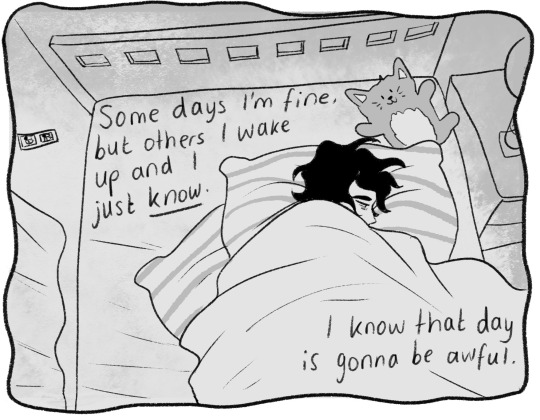
(pages 1198, 1216 and 1205)
#heartstopper#alice oseman#charlie spring#nick nelson#osemanverse#nick x charlie#mental health#cognitive behavioral therapy#therapy
97 notes
·
View notes
Text

6 notes
·
View notes